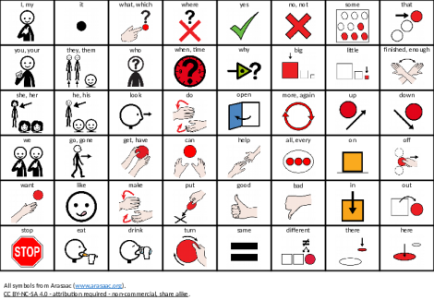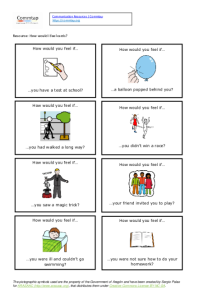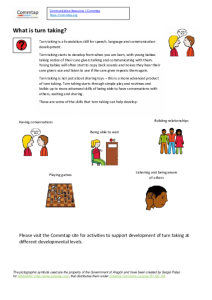Search
User login
Topic “Conversation skills”
Core communication board
Core communication board using ARASAAC symbols (https://arasaac.org). For use with everyday communication.
Note: if re-distributing with the ARASAAC symbols, this must be done non-commercially only.
You can make your own core communication board using different symbols with the Commtap Symboliser for PowerPoint.
Created 25 June 2022; updated 6 December 2024.
Barrier game ideas
Barriers
Create a barrier so one person cannot see what the other person is doing. You could:
- Use a large hardback book
- Use two single fold files, stapled together to make a Π shape
- Use a ring binder (empty)
- Seat children back-to-back (only really suitable for paired work)
Games
Set of cards
think and talk about events in the past and future
| Activity/strategy name and materials required | How to do the activity | Key principles for doing the activity and comments |
|---|---|---|
| Which day? Sheet of paper with 3 boxes drawn on them for yesterday, today and tomorrow. A counter. Optional: sets of symbol cards or pictures showing a variety of activities - including activities the student may have done. You can create symbols cards using the Commtap Symboliser for PowerPoint. | 1. Talk about each day, one at a time. Get the student to draw or write things they have done or will do in each box. Use the picture symbols if the student is having difficulty coming up with things. 2. When you have finished, explain that there is going to be a quiz. Describe an activity and the student must say if they did it yesterday, did it today or will do it tomorrow. 3. Have them step the counter over onto the right day. | This works best when there are key things which are different about each day! |
| The Story of Fred Set of three pictures - one showing a picture of a child, one showing a picture (preferably of the same person!) at a similar age to the student and one a picture of an older person. These could be photographs or drawings. Choose three ages which are appropriate/relevant for the student.
Large 'thought clouds ' on A3 or A4 paper: Sticky tape Pens Picture symbol prompts if required. You can create symbol prompts using the Commtap Symboliser for PowerPoint. | ||
| Calendar Calendar Pens | This is an ongoing activity. You could take photos of the key events, and put them on the calendar. | |
| Daily Schedule/Picture Schedule Any activity or set of activities where the student might use a schedule or have a visual timetable. You can create a visual timetable/schedule using the Commtap Symboliser for PowerPoint. |
Share information about self with others
| Activity/strategy name and materials required | How to do the activity | Key principles for doing the activity and comments |
|---|---|---|
| Likes and dislikes Optional - something to record the students responses on (e.g. paper/pen) which can later be used as a prompt; Soft ball or beanbag. |
| To make it harder, you can go around again asking for favourite drinks - so that everyone now has to remember a food and a drink for each student when they pass the ball (e.g "Tim - you like carrot cake and tea"). You could use favourite games, favourite places to go, etc. instead. |
Talk about things in the recent past
| Activity/strategy name and materials required | How to do the activity | Key principles for doing the activity and comments |
|---|---|---|
| What have you done today? Optional - way of recording students responses - e.g. paper/pen, whiteboard/marker |
| Variations
|
| What have you done today - with a ball Optional - way of recording students responses - e.g. paper/pen, whiteboard/marker Soft ball or beanbag |
Say how you would feel in situations
| Activity/strategy name and materials required | How to do the activity | Key principles for doing the activity and comments |
|---|---|---|
| How would you feel if?: - Pictures/photos of different emotions - a printable set of emotion cards are available here. | 1. Print and cut out the resources. 2. Introduce the activity by having a quick discussion of how it's fine if different people feel differently about the same situation. 3. Take turns to choose a situation card and discuss it together. See if you can match how you would feel to the emotions symbols or pictures. 4. Some children may be able to explain why they'd feel that way e.g. "I'd be scared if I saw a spider because I don't like them'. | Reinforce the idea that there's no 'right' answer. |
Ideas to encourage playing with one friend then playing with someone else
| Activity/strategy name and materials required | How to do the activity | Key principles for doing the activity and comments |
|---|---|---|
| Story Story script - see "Robert's Friend" (https://en.commtap.org/additional-resource/roberts-friend), or make up your own story (two main characters and two others - one of the main characters wants to play with their friend the whole time, and they fall out). | Explain to the child / children that you are going to tell them a story. They need to tell you what the characters did that was good and what was not good. Tell the story, and repeat it. Discuss. Talk about what the characters could do differently. | Make sure you talk about: - Do we need to play together all the time to be friends? - Do friends sometimes play at different games? - What happens if we try and play with one person the whole time? |
| Role-play with puppets Puppets / paper figures Story script used above | ||
| What to do if...your friend wants to play with someone else? A3 sheet of paper pens Flash cards (optional) Puppets (optional) | Key strategies: - Ask someone else to play with you - Choose something else to do - Say, 'ok, see you later'. - Ask an adult to play with you. - Ask if you can join in someone else's game. - Remember that it doesn't mean they don't want to be your friend - they just want to play with someone else for a bit. | |
| 'I would like to play a game with...' card Laminated card 'I would like to play a game with...' Sticky notes Pen Some simple games Timer (optional) | This can be used in the playground, provided there are at least two children who are willing to be chosen. If there are, the activity will be to play a specific game, for a set time, and then to play with someone else. |
Joins in discussion about a story
| Activity/strategy name and materials required | How to do the activity | Key principles for doing the activity and comments |
|---|---|---|
| Sharing big book at carpet time | 1. Define child's sitting space with carpet tile or tape. Always use the same space for big book time. (This might not be necessary for all children). 2. Start with short periods of shared sitting and listening to a story and build up to longer times. Using an egg timer may help to establish the idea of good sitting initially. When good sitting is established the timer can be removed. 3. If asking a question about the shared book to a group always use the child's name to alert him/her to a question - even a question addressed to the whole class. 4. Start by asking questions you know the child can answer. 5. If necessary focus the child's attention by taking his/her hand and pointing to/touching the relevant part of the book 6. Allow the child a chance to pre-read the big book so that events are already familiar. | Be clear about expectations but keep them reasonable You could use a visual timetable to indicate that it is big book time or that the big book time is finished. |
Support Commtap to keep it online
Thank you for visiting Commtap.
Please read this message as it is extremely important.
- Visitor donations mean we can continue to host over 1,000 free activities to support speech, language, and communication development.
- Visitor donations mean we can continue to provide free resources to address a wide range of communication needs, including limited speech or language, interaction challenges, and needs associated with conditions such as developmental language disorder, autism, and cerebral palsy.
- Visitor donations mean we can continue to provide resources to support the work of speech and language therapists, teachers, teaching assistants, parents, and carers.
- Visitor donations mean we can continue to provide the free key word sign dictionary (bks.org.uk) which has over 2,000 Makaton and Signalong signs.
We know that not everyone is able to afford to pay to access these resources, however, if you can, please make a donation to keep the site going.
Thank you
Google ads on this page are provided by Google Adsense - and their presence does not imply any endorsement by Commtap. Report a problem with an ad on this page. Log in (for free) to avoid seeing Google ads.





